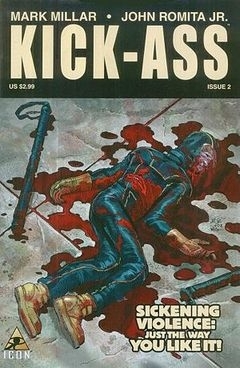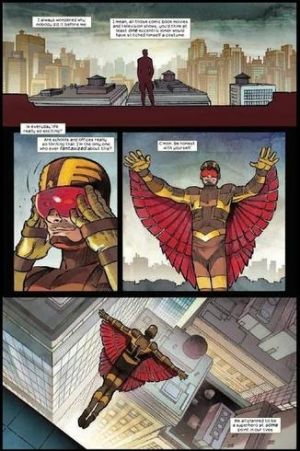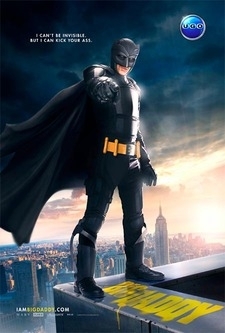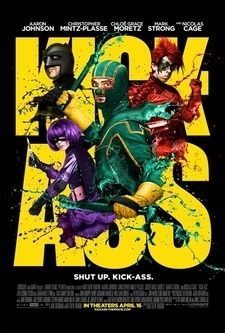Comics /
Spotlight
Kick Ass: Retrospective and Anticipation
By Zak Edwards
April 7, 2010 - 11:29
So it has happened, the world has, in a significantly shorter amount of time, created a mythos of comic book characters and stories on film which, in many ways, reflects the comic book world itself. This new age of the superhero in film, starting very arguably with the first X-Men film, is now in a post-Watchmen world. By post-Watchmen world I mean the impact Watchmen had on the industry and superhero genre: the infusion of literary techniques, influence, and mature thematic notions into a comic, the inversion of commonplace tropes of the genre, the challenging of works to consider the genre in a very different space, to name a few. Films like Batman, which bring into a very different light the superhero when contrasted with a more traditional story portrayed in Iron Man or, heaven forbid, Superman, are making money but also becoming vehicles for discussing the pressing issues of society, a marker of continued maturity. Even retcons, the plague of the comic book world, have occurred. The Hulk franchise saw a reboot only a couple of years ago after the Ang Lee ‘run’ failed to turn heads. But back to Watchmen, now that this movie has come out to considerable exposure at least, how will Hollywood now work with a film like Kick-Ass, which is really a continuation of Moore and Gibbon’s famous series, albeit in a very different way.
 |
| This cover really encapsulates the series: The grotesque, the burlesque, black humour, and mockery of the superhero. |
Kick-Ass, as a comic book, represents many things in the contemporary comic book climate. First off, the movie offer preceded the first issue, something which occurs fairly often in the novel realm (Nick Hornby’s novel “A Long Way Down” had its movie rights purchased by Johnny Depp before it was published). This obviously changes the way in which the book was constructed, having a very cinematic style with a length appropriate to the length of a film. Of course, the book does things I don’t imagine the film will, including the panel of a character getting his head shot from behind at point blank range. But as a book, what is Kick-Ass doing? The book represents an ongoing theme in writer Mark Millar’s work, which seeks to come to terms with the very idea of the superhero in a contemporary climate while taking for granted the successful experiment of Watchmen. Ultimates explored this from a political front in terms of both contemporary political climate and in terms of impact on society. The Ultimates are not superheroes, but persons of mass destruction, they cost billions of dollars a year, they are used in American global interactions without public knowledge, and they are media sensations. The political impact of the superhero is seen also in Superman: Red Son, which had baby Clark Kent land twelve hours later in Cold War Ukraine, reversing the political relationship seen in Watchmen with Dr. Manhattan. Wanted, by contrast, explored the notion of the supervillain, with the usual amoral and black humour associated with Millar’s style.
 |
| This scene is central to the ambiguous yet critical approach to the impact of violence in Kick Ass |
In Kick-Ass, Millar is bringing many of these themes into an often thought of but rarely well-executed subgenre of the superhero: the real life superhero. Dave “Kick Ass” Lizewski has no powers, is beyond average to the point of almost invisibility, and has an origin which generally makes fun of the superhero story (dead mother, but wonderfully handled in two great panels, which juxtapose a typical cry for vengeance with Dave playing video games while his father cries behind him). Initially, he gets the crap kicked out of him regularly, spends a considerable time in hospital. The signs usually leading to someone discovering who he is that are generally masked in many superhero books, namely the regular physical injuries, are misinterpreted by his peers to be either regular muggings or the consequences of him prostituting himself. These aspect raise Kick Ass to the level of burlesque, not in the Pussycat Doll sense, but in the exaggeration sense used commonly throughout literature (Antony's death scene in Shakespeare's Antony and Cleopatra is a perfect example of the burlesque). Even when a couple of characters more similar to superheroes than Kick-Ass are discovered, they are more Punisher than Batman, killing bad guys regularly, while their origin story continues to mock the origin stories of many heroes (Manhunter and the Punisher come to mind). Nevertheless, ‘Big Daddy’ is actually an accountant with an unhealthy addiction to comics, like Dave, drawing Big Daddy’s psychopathic tendencies closer to Dave’s less violent forms. What Kick-Ass is, in terms of a comic, is a continued discussion of the superhero genre and its capabilities, mostly executed through a combination of direct satire and black comedy. Millar is ambiguous on Dave’s impact on society. Yes, he brings down the mob, saves a girl from a grown-up version of himself, and inspires others to act as selflessly/selfishly as himself. However, the circular point of the conclusion, with a man in a bird costume going to the top of the building to accidentally kill himself, questions the positive impact of the superhero on society. Two things come to mind: James Gordon’s discussion of escalation at the end of Batman Begins, and the first Daredevil story by Brian Michael Bendis, which focuses on a little boy who has been committed after witnessing Daredevil beat up his supervillain (and abusive) father.
 |
| Big Daddy's costume makeover increases the resemblance to Batman, both in colour and style. This change focuses the critique on the commonplace tropes and cliches present in the superhero genre. |
Kick-Ass, the film, is self-consciously making similar moves. Just as the movie Nite Owl II has a costume change to reflect Batman, so does the Big Daddy Character, who is now blatantly copying Batman. Similarly, the colour scheme of the film is predominantly bright colours, a choice seen also in the book, mocking the pulpy and light colour schemes seen in films like Superman Returns. The film is obviously going further with the comedy aspect in a very Freudian manner. Freud has an idea of the joke as a means through which people can express repressed feelings, the movie obviously using this technique to attack superhero convention, turning (if the movie stays somewhat loyal to the source material) the ending into a joke in itself. Remember, Kick Ass is not saving the world, he went out and looked for the trouble. The villains in Kick Ass were not ‘active,’ pursuing Dave and attempting to harm him for whatever reason, he brought the fight to them. Does saving the day, in this context, really hold a happy Hollywood ending? This critique of superhero conventions is also explored through the gratuitous violence the film seems to stick to as well. Not to the extent of the book, books always are capable of much more (Naked Lunch came out in the fifties and still has the capacity to grossly offend even those who think of themselves as not easily offended), but the level of violence highlights a gap in the superhero genre usually glossed over. Shooting someone is not an easy thing to happen, people do not have a biology as to simply get a red spot and keep fighting when shot anywhere. The film takes it further in a somewhat disappointing manner, with Hit Girl appearing to be able to dodge bullets with some amount of ease. Despite this, the movie seeks to deconstruct many tropes found in both the action genre (which has been done in films like Shoot ‘Em Up) and superhero films. The release is of interest as well, with the summer blockbuster season and Iron Man 2 looming (which I am certain I will enjoy). Kick-Ass is setting itself up as a point of criticism, and the fact a British director is heading the project means confidence in the dry and unconventional British-style humour present in the book will continue into the film adaptation. Finally, the private financing of the film could work towards a continued faith in the alternative system to the studio blockbuster model used for most superhero films, reflecting, in part, Millar’s creator owned approach to Kick Ass the comic book.
 |
So what does Kick Ass represent as a film? Mostly an opportunity to build off of the growing critique of the superhero in film. Hancock tried (in a mediocre fashion), Watchmen established the more dramatic form, and Kick Ass is setting itself up to continue a critical discourse of the superhero genre. If the film is what the trailers suggest, the parody, satire, and black humour are powerful engines to mock to genre, especially with superhero on the mind with summer lurking behind the corner. If the film becomes too much ‘Hollywood,’ than with other films who lose their way, this will lose its significance and the film will not only lose money, but confidence in the self-financed project it is built from.
The compete first volume of Kick-Ass is available wherever (comic) books are sold.
The Kick Ass film is already released in Britain, with the film hitting theatres in North America on April 16.
Last Updated: March 3, 2025 - 20:40



